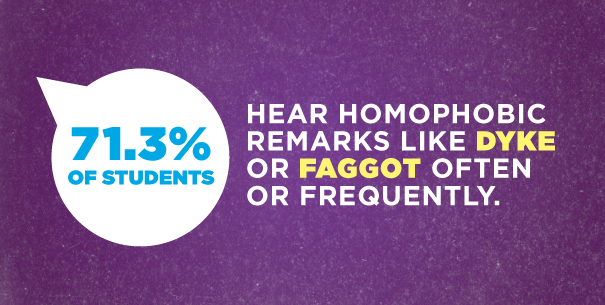Anti-LGBT bullying forms an unfortunate part of many students’ public school experience. Bullying based on sexual orientation or gender expression continues to hinder many students’ educational performance and can affect students’ personal lives, mental health, and living situations.
Grassroots organizing has previously been used as a way to improve school conditions involving students, parents, and key professionals working together to improve students’ education experience as well as in-school conditions. With a positive track record in other fields, can grassroots organizing be seen as a possible method to curb in-school bullying and better the lives of LGBT students?

Image Source
Every two years the Gay Lesbian & Straight Education Network conducts the National School Climate Survey which aims to paint a picture of school environments and the lives of many LGBT students lives. In 2013 the GLSEN made a number of key findings, including –
55.5%
of LGBT students felt unsafe at school because of their sexual orientation
68.1%
Avoid school functions or extra-curricular activities because they felt unsafe or uncomfortable
90.8%
Felt distressed because of the level of anti-LGBT language used at school
51.4%
Heard homophobic remarks from teachers or school staff
61.6%
of students who reported incidents of bullying, harassment, or assault to school staff said that nothing was done in response
17.5%
of students were prohibited from discussing or writing about LGBT topics in school assignments
LGBT students who experienced sexual-orientation-based victimization had an average GPA of 2.8 vs the non-harassed average of 3.3
These facts paint only a small part of the picture. While bullying against LGBT youth is clearly present across the nation’s schools, more needs to be asked about how the bulling affects students and how it prevents them from learning effectively.
With the focus of public schools’ education shifting to goals rooted in tangible targets, such as standardized testing, less and less attention is being paid to holistic educational goals. While testing-oriented teaching shifts the educational landscape for all students, LGBT students in particular stand to lose more than their peers.
Research has shown that LGBT students perform, on average, poorer than their non-LGBT peers. LGBT students who experienced discrimination at school are more than twice as likely to have missed school in the past month than their peers 1. With the rising evidence suggesting that ‘teaching to the test’ takes place during class time, it is clear that LGBT students, who miss more school, are at a disadvantage in terms of preparedness for their tests.
Another function of education is to help develop non-cognitive abilities such as self-control, curiosity, and self-confidence. However according to social scientists the success of this development is threatened by social and environmental stressors 2. Research has lead to the creation of a rating system to quantify such stressors the, HPA Axis. While such studies are relatively new and face certain challenges, there is plenty of opportunity to deduce conclusions, based on what has been proven, on the outcome on students’ lives based on the research.
Many social scientists believe that LGBT students are prone to facing difficulties dealing with increased levels of social and environmental stressors. One needs to consider the “pervasive” nature of anti-LGBT bullying, where everyday actions such as going to school or socializing are opportunities for “harassment and victimization” 2. GLSEN continues to solidify claims that LGBT students face such issues. Considering the research, it is easy to see a link between LGBT victims and increased stress levels, leading to impaired non-cognitive skill development.
What makes this so concerning is the fact that when victims don’t develop skills in-line with their peers, the effect continues to hold them back socially and academically even after the discrimination ends.
Identifying the factors that lead to anti-LGBT bullying and discrimination can help inform efforts on what action needs to be taken. Heteronormativity in society clearly plays a factor as it has the opportunity to not only influence the attitudes of parents of LGBT students, as well as their peers, but also teachers, administrations, and decision and policy makers. In many classrooms across the country LGBT issues are often only mentioned, if at all, in the context of disease, namely HIV/AIDS 3 – 37. This leads to a strictly negative image being painted by school officials and teachers, legitimizing heteronormativity.
Research continues to suggest that school environments institutionally ignore LGBT students and their issues – they are silenced. (3 – Payne and smith 2011:175)
Heteronormativity can have many negative impacts on LGBT students’ educational and social experiences. It also creates an uncomfortable environment in the classroom. Students are often unable to speak freely about their beliefs, with many high profile cases of students being silenced when attempting to speak out. One school in Tennessee, to prove as just one example, silenced students aiming to show support for LGBT students who attempted to host a “Week of Pride”. It was shut down by officials who claimed that rainbow flags and messages of support for LGBT students “advertise or promote sex” 4.

